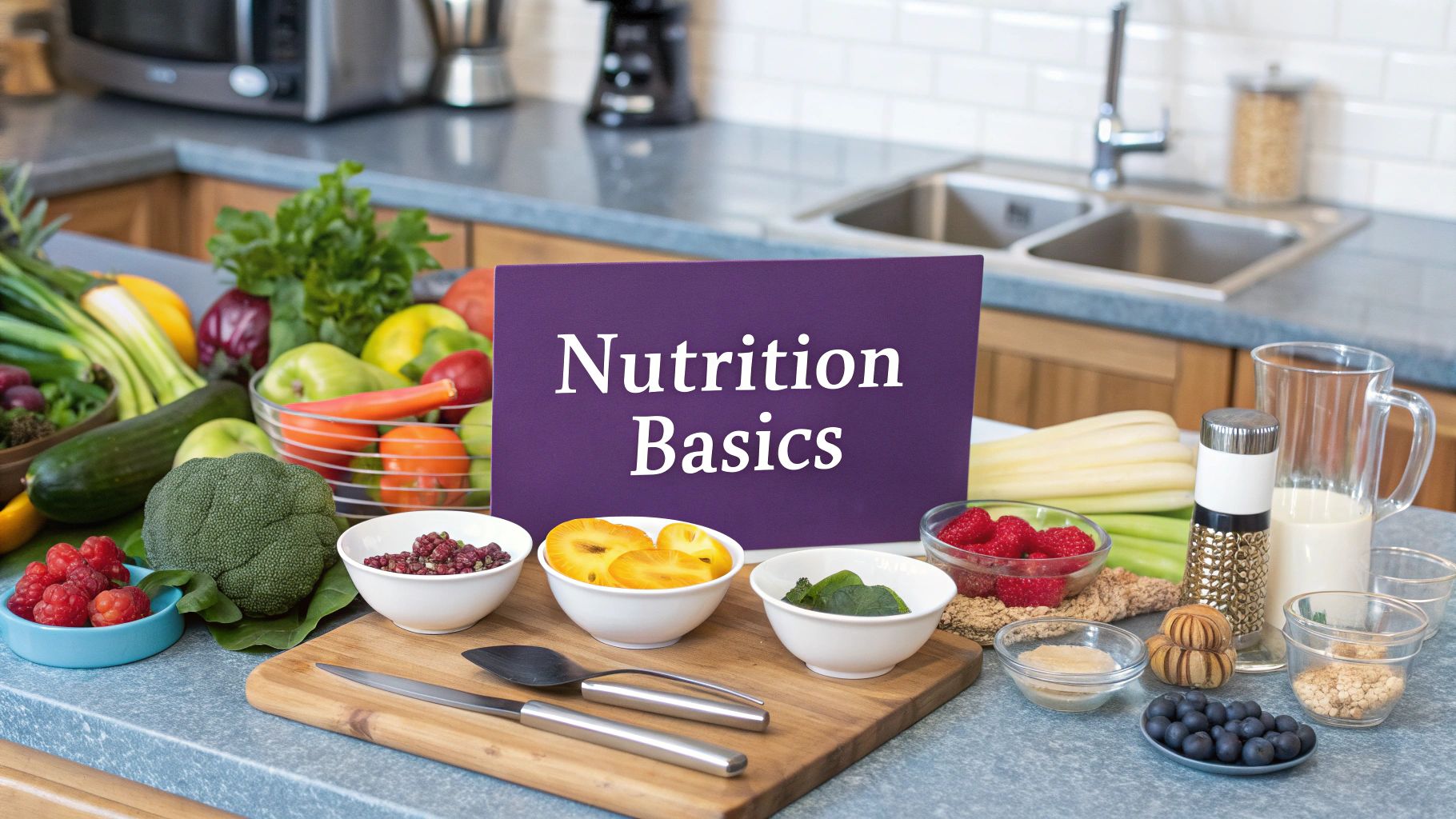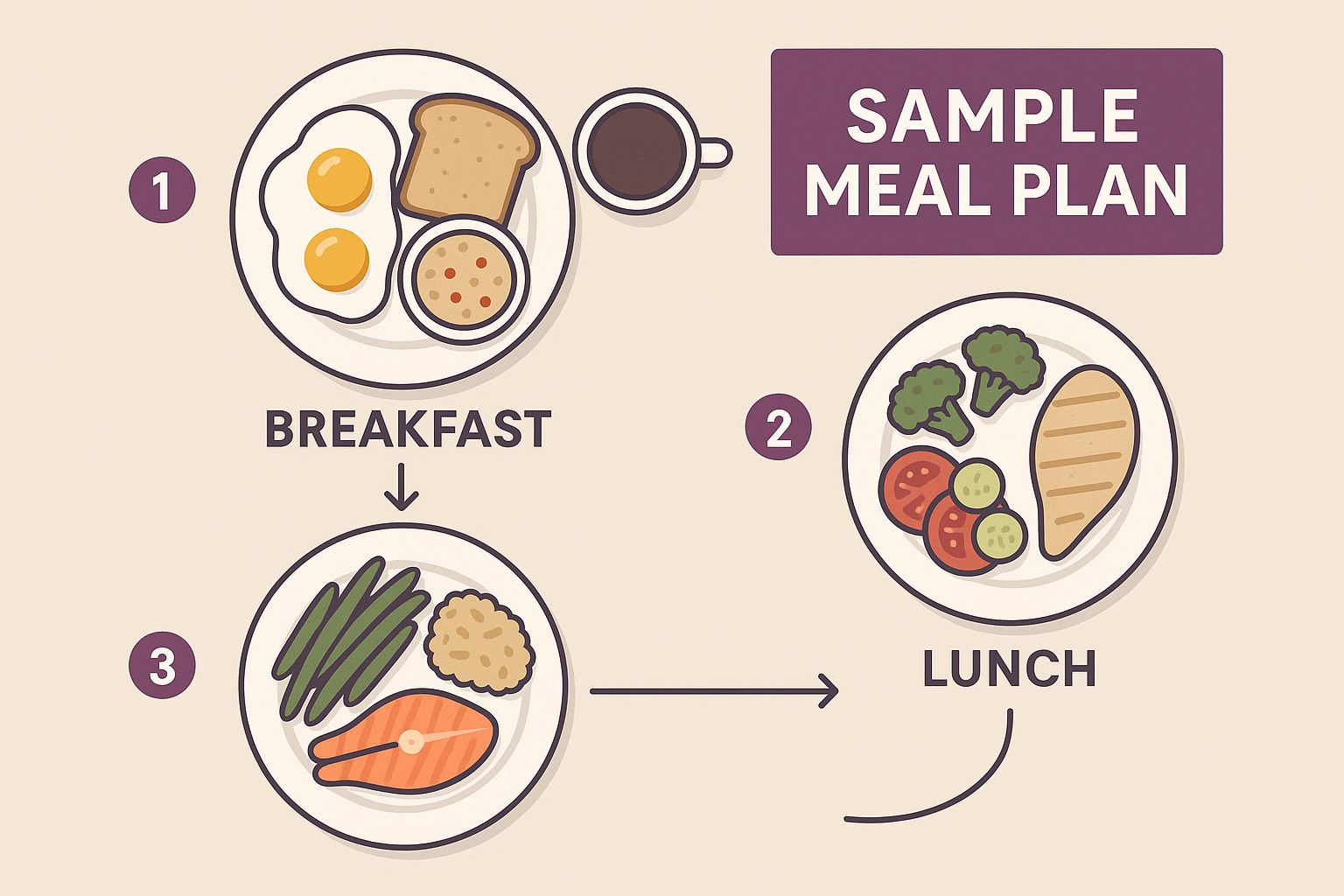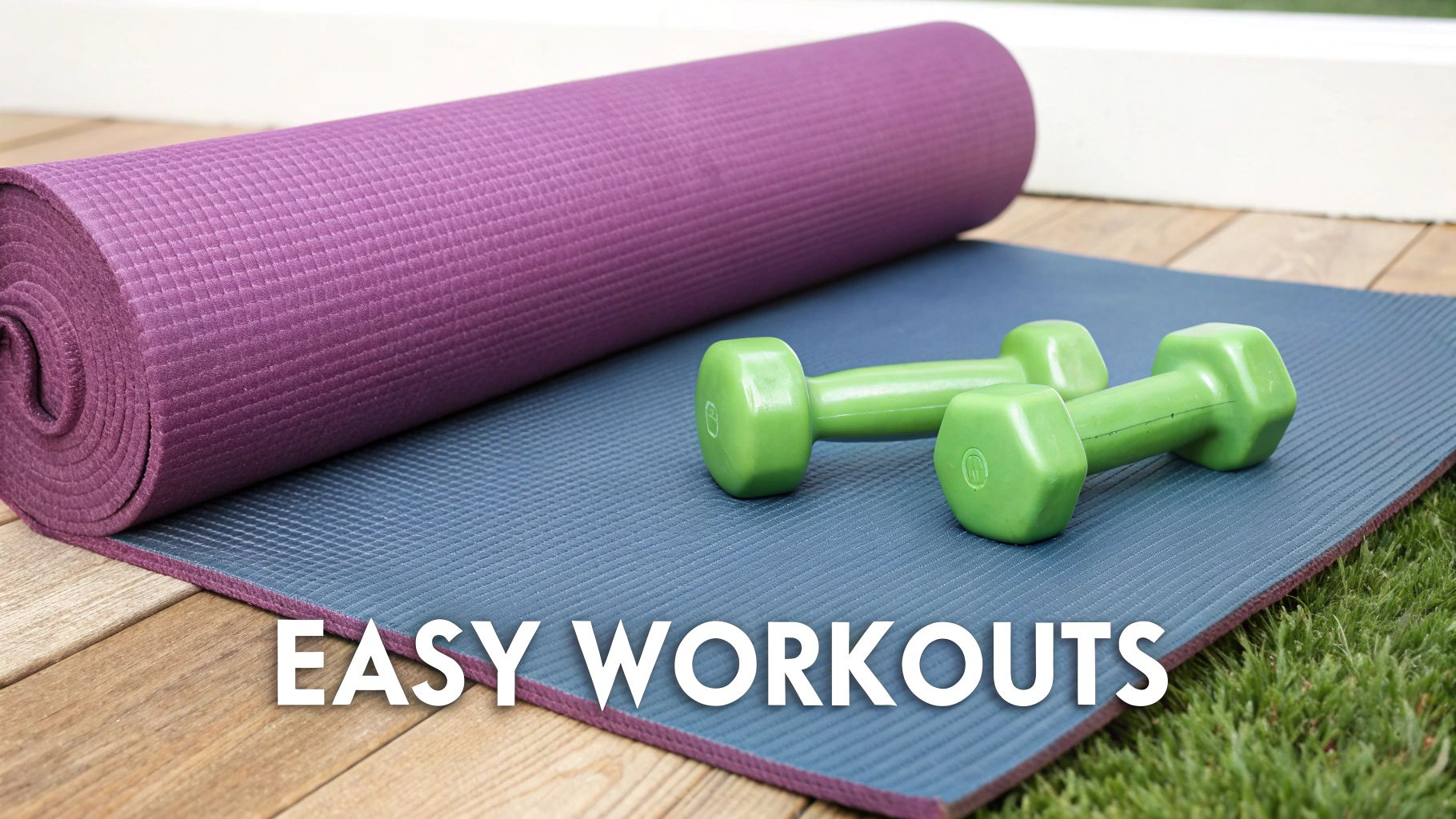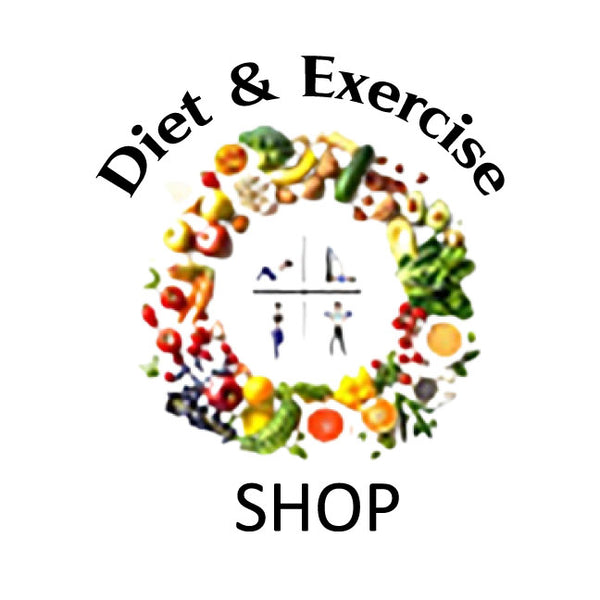
Your Complete Diet and Workout Plan for Beginners
Starting a diet and workout plan as a beginner is all about one thing: building sustainable habits. Forget about drastic, overnight transformations. True success comes from creating a lifestyle that leaves you feeling stronger, healthier, and more energetic for the long haul.
Setting Realistic Goals For Your Fitness Journey
Beginning a new fitness routine can feel overwhelming. With so much conflicting advice out there, it's easy to get lost. The most important first step isn't about extreme diets or punishing workouts; it's about setting a solid foundation with realistic goals.

Let go of the idea of a 30-day quick fix. The real objective is to create healthy habits that stick. This means defining what "healthy" and "fit" mean to you, not what you see on social media.
First, Figure Out Your "Why"
Before you lift a single weight or plan a single meal, ask yourself: Why am I doing this? Is it for more energy, confidence, or stress relief?
This "why" is your fuel for the days when motivation is low. Write it down and put it somewhere you'll see it daily. This personal connection is far more powerful than a vague goal like "get in shape."
Get SMART With Your Targets
A goal like "I want to get in shape" is too vague. Using the SMART framework helps create clear, actionable targets.
Here’s how it works for a beginner's plan:
- Specific: Instead of "eat healthier," try "I will add a serving of vegetables to every dinner."
- Measurable: Swap "work out more" for "I will complete three 30-minute workouts each week."
- Achievable: Aim for small wins. "In four weeks, I will be able to jog for 10 minutes without stopping."
- Relevant: Ensure your goal connects back to your "why."
- Time-bound: Set a deadline, like "I will lose 5 pounds in the next 30 days."
This approach turns a huge mountain into a series of small, manageable hills, building your confidence with each win.
Your First 30 Days Fitness Goal Framework
| Fitness Goal | Example Action Step | How to Measure | Helpful Product |
|---|---|---|---|
| Improve Cardiovascular Health | Walk/jog for 30 minutes, 3x per week. | Use a fitness app or watch to track time and distance. | A good pair of running shoes. |
| Increase Strength | Complete 2 full-body resistance training sessions per week. | Log the weight and reps for each exercise. | Resistance Bands for home workouts. |
| Better Nutrition Habits | Drink 8 glasses of water daily. | Use a water bottle with measurements or a tracking app. | A reusable 1-liter water bottle. |
| Improve Flexibility | Stretch for 10 minutes after each workout. | Note how much further you can stretch week-over-week. | A quality yoga mat for comfort. |
Setting clear targets is the difference between wandering aimlessly and walking a clear path toward your goals.
Gearing Up For Success At Home
You don't need an expensive gym membership. Building confidence at home is a great way to start, a trend supported by insights on health and fitness marketing trends.
To set yourself up for success, a few key pieces of equipment can make all the difference. Our Beginner's Fitness Starter Kit was designed specifically for this. It includes essentials like high-quality resistance bands and a durable yoga mat, giving you the tools to perform dozens of effective exercises right in your living room.
Building Your Beginner's Nutrition Foundation
Figuring out what to eat can be confusing. The secret is simplicity. A solid diet and workout plan for beginners starts with understanding the basics of nutrition, not restriction.
Think of food as fuel for your body. The right mix is essential for energy, recovery, and results.
The Big Three: Protein, Carbs, and Fats
Your diet boils down to three "macronutrients":
- Protein: The Builder. Essential for muscle repair and growth after workouts. Find it in chicken, fish, eggs, and Greek yogurt.
- Carbs: The Energizer. Your body's main fuel source for exercise. Choose complex carbs like oats, brown rice, and sweet potatoes for sustained energy.
- Fats: The Regulator. Healthy fats are vital for hormone production and vitamin absorption. Good sources include avocados, nuts, and olive oil.
A simple way to build a balanced meal is to fill half your plate with veggies, a quarter with lean protein, and a quarter with a complex carb.
The Post-Workout Shake: Your Recovery Shortcut
A post-workout protein shake is an easy and effective habit. After exercise, your muscles are ready to absorb nutrients for repair.
Mixing a scoop of our Premium Whey Protein with water or milk is a simple solution. It delivers 25 grams of high-quality protein right when your muscles need it most, making a real difference in your recovery and results.
A Simple One-Day Meal Plan Example
Here’s a sample day of eating to guide you. Use it as a template to build your own confident meal choices.
Breakfast (7 AM): Scrambled eggs with spinach and whole-wheat toast. This provides a balance of protein, carbs, and vitamins to start your day.
Lunch (12 PM): A large salad with grilled chicken and mixed greens. The lean protein keeps you full while veggies provide fiber and nutrients.
Snack (3 PM): An apple with a handful of almonds. This mix of fiber and healthy fats is perfect for beating the afternoon slump.
Dinner (6 PM): Baked salmon with roasted sweet potatoes and broccoli. Salmon is packed with protein and omega-3s for muscle recovery.
Don’t Forget to Hydrate
Water is crucial for every fitness plan. Aim for at least 8-10 glasses a day to maintain energy levels and performance. Carrying a reusable water bottle is a great way to stay on track.
If your goal is weight loss, understanding energy balance is key. You can learn more about how a calorie deficit works for weight loss in our guide. For quick breakfast ideas, check out our 5-Minute Healthy Breakfast Ideas video on the @dietexercise channel.
Your First Four Weeks of Foundational Workouts
Now it's time to put your nutrition plan to work. This four-week workout plan is designed for absolute beginners, focusing on consistency over intensity.
The plan uses three full-body workouts per week, giving your muscles ample time to recover and grow stronger.
The 'Why' Behind This Approach
Full-body workouts are efficient for beginners because they target all major muscle groups at once. This boosts your metabolism and builds functional, real-world strength.
We focus on compound movements like squats and rows, which work multiple muscles simultaneously. Perfecting your form is more important than lifting heavy or rushing.
Don't Skip The Warm-Up and Cool-Down
A 5-10 minute warm-up is essential to prepare your body and reduce injury risk. Include light cardio like jumping jacks and dynamic stretches like arm circles and leg swings.
A 5-minute cool-down with gentle stretching helps your body recover and can reduce next-day soreness.
Your Four-Week Foundational Plan
This plan is built on progressive overload—gradually increasing the challenge to get stronger. Perform the same core workout three times a week on non-consecutive days (e.g., Monday, Wednesday, Friday).
Focus on good form and aim to improve slightly each week, whether it's one more rep or a slightly heavier weight.
Sample Beginner Workout Week At A Glance
| Day | Activity | Focus Area | Recommended Equipment |
|---|---|---|---|
| Monday | Workout A | Full Body Strength | Bodyweight & Dumbbells |
| Tuesday | Active Recovery | Light Movement | Yoga Mat |
| Wednesday | Workout A | Full Body Strength | Bodyweight & Dumbbells |
| Thursday | Active Recovery | Light Movement | Your own body |
| Friday | Workout A | Full Body Strength | Bodyweight & Dumbbells |
| Saturday | Rest | Full Recovery | None |
| Sunday | Rest | Full Recovery | None |
This schedule of work and rest is key to building strength without burning out.
The Workout A Routine
Perform each exercise for the sets and reps listed, resting 60-90 seconds between sets.
- Bodyweight Squats: 3 sets of 10-12 reps.
- Push-ups (on knees or toes): 3 sets of as many reps as possible (AMRAP).
- Dumbbell Rows: 3 sets of 10-12 reps per arm.
- Walking Lunges: 3 sets of 8-10 reps per leg.
- Plank: 3 sets, hold for 20-30 seconds.
As you get stronger, an Adjustable Dumbbell Set is a great investment. It grows with you, allowing you to increase weight in small, manageable increments. It’s the perfect tool for long-term progress.
This image shows how a balanced meal plan provides the energy you need for these workouts.

The graphic illustrates that the right mix of protein, carbs, and fats is crucial for fueling workouts and repairing muscles.
For more ideas, explore our other workout routines for beginners you can do at home.
Choosing The Right Gear For Your Goals
The right equipment removes barriers between you and your goals. Think of these as smart investments in a stronger, healthier you.

From tracking progress to making healthy eating effortless, the right gear can be a game-changer.
Data-Driven Motivation With A Smart Fitness Tracker
Seeing your numbers improve is incredibly motivating. A quality fitness tracker provides the data you need to stay on course.
Our Smart Fitness Tracker Watch monitors key metrics that impact your results, including sleep quality, heart rate, and daily activity. Using technology to support your fitness journey is the new normal, a trend you can explore further by reading about the future of fitness.
Protect Your Foundation With The Right Footwear
A good pair of training sneakers is your most important piece of gear. They provide critical support to prevent common injuries like shin splints and knee pain.
Our High-Support Training Sneakers are engineered for varied movements, offering a stable base for lifting and cushioning for impact. This isn't about fashion; it's about performance and staying injury-free.
Make Healthy Eating Easy With Meal Prep Containers
Consistency in the kitchen is just as important as in the gym. Meal prepping is the secret weapon to ensure you always have healthy food ready.
Our Meal Prep Container Set makes this process foolproof. The built-in compartments simplify portion control, and their durable, BPA-free design is perfect for a busy lifestyle. When healthy meals are prepped and waiting, you eliminate decision fatigue.
Staying Motivated: How to See Real Progress
Initial excitement fades, but true momentum comes from tracking your progress and understanding what motivates you. The bathroom scale doesn't tell the whole story, especially when you're building muscle.
Look Beyond the Scale
Celebrate "non-scale victories"—the real-world signs that your hard work is paying off.
- The fit of your clothes: Are your jeans looser?
- Your energy levels: Do you feel more energized throughout the day?
- Your strength gains: Can you complete more reps or hold a plank longer?
These tangible proofs of progress are often more motivating than a number on a scale.
The Power of a Simple Journal
Keeping a fitness journal is a game-changer. Jot down your food, exercise, and how you felt. Seeing patterns emerge over time helps you connect your actions to your results.
Track Your Progress with Precision
To truly understand your body's changes, you need to look at its composition. A standard scale can't do this.
The Advanced Body Composition Scale measures the metrics that show true progress, like body fat percentage and muscle mass. Seeing your body fat drop while muscle mass climbs is powerful validation that keeps you going.
Remember, the goal is consistency over time, not perfection. If you have an off day, just get back on track with your next meal or workout.
Got Questions About Starting Your Fitness Plan? We’ve Got Answers.
It's normal to have questions when starting a new plan. Here are answers to some of the most common ones.
How Soon Will I See Results?
You'll likely feel a difference in energy and sleep within the first few weeks. Visible changes typically become noticeable after 4-8 weeks of consistent effort. Stick with your plan, and you will see progress.
Is Diet or Exercise More Important for Weight Loss?
They are partners. Nutrition often drives initial weight loss, as it's easier to create a calorie deficit through food choices. Exercise builds metabolism-boosting muscle and helps you maintain your results long-term. The winning strategy is always a combination of both.
Is It Normal to Be Super Sore After Workouts?
Yes! This is called Delayed Onset Muscle Soreness (DOMS), and it's a sign your muscles are adapting and getting stronger. It usually fades in a day or two.
To manage soreness, warm up properly, stay hydrated, and get enough protein. A Foam Roller is an excellent tool for easing tightness and speeding up recovery, helping you get back to your next workout feeling great.
What's the Best Way to Stay Motivated?
Motivation is unreliable; habits are what carry you through. Focus on building a consistent routine. Start small, find activities you enjoy, and track your progress to see how far you've come.
Here at dietexerciseshop.com, our goal is to give you the tools and knowledge to build a healthier, stronger you. Our gear is built to support you at every stage of your fitness journey.
Check out our collection of fitness essentials to find what you need to hit your goals. Visit dietexerciseshop.com to gear up for success!
